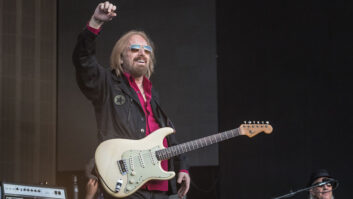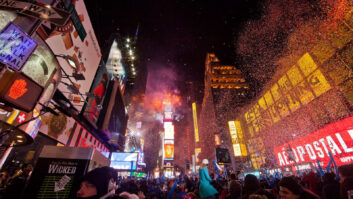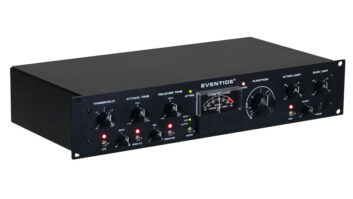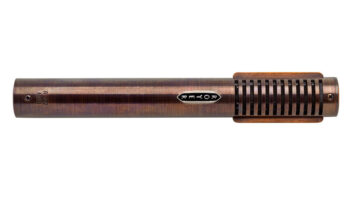Much like the Wizard of Oz in Ryan Ulyate’s hand, he wants High-Res Audio to help pull back the curtain, revealing what well-recorded music sounds like. LOS ANGELES, CA—Nearly 37 years after their debut record first entered the Billboard 200, Tom Petty and The Heartbreakers scored their first U.S. Number One album in August with Hypnotic Eye. This latest collection, featuring tracks recorded periodically over the past three years, was co-produced, recorded and mixed by longtime band associate Ryan Ulyate, and released in a variety of formats.

“I’ve been doing this for 38 years; I’ve finally got a number-one record,” laughs Ulyate. “It proves that if something is really good, then people will embrace it.”
Hypnotic Eye was tracked at the band’s hangout, The Clubhouse, a commercial warehouse with a room measuring about 160 feet by 80 feet. with a 20-foot ceiling, says Ulyate. The musicians set up as if on stage, with the drums on a riser, and all play together, making changes to arrangements on the fly as necessary.
“We’ve got Tom facing the drums, so we’ve got the dead side of the mic towards the drums. We have a plastic screen up; [drummer Steve Ferrone] is not completely in a booth, so we get some leakage,” he reports.
“The room mics are really fun. You get the whole band in them, not just the drums. The room sounds pretty good.” The space was initially put together and acoustically treated in 2007 by crew chief Alan “Bugs” Weidel for the album Petty made with the reunited Mudcrutch, which was formed in 1970 and included several soon-to-be-Heartbreakers.
All the inputs run through the preamps of monitor engineer Greg Looper’s Avid Venue. “They’ve got wedges; they don’t have headphones. That’s part of what really makes working with these guys in this way special—they’re not aware that they’re tracking a record. They’re playing live, listening to each other, making music,” says Ulyate, who operates Pro Tools in another room.
“I can record the whole day. I’m able to take what they’re doing and try and make it sound cool, so that when they walk in and listen [I can say], if it’s a record, it would sound like this.”
The tracks are then taken over to Petty’s Shoreline Recorders for overdubs and mixing. “Tom’s got a vintage Neve at his place. We’re coming out of Pro Tools and monitoring through the tape returns. We did track some drums there for a couple of songs, and did some guitar overdubs and vocals. In that case, I’m using the full-on analog as much as I can.”
That said, some Clubhouse vocals made it into the mix. “On “American Dream Plan B,” we ended up using the chorus from the live tracking session. Inside his vocal, you’ve got the splat of the drums, the guitar amps, and a little bit of trash; it adds a little vibe.”
On this album, Ulyate made use of Sound Toys’ Decapitator plug-in more than usual. “I’m a real big fan of distortion on basses these days; it’s my new thing. In a funny way, it has to do with the fact that if you put all that harmonic content on a bass, if you listen on tiny speakers, you can hear it better. We used some of that on Tom’s vocal, too, like on the verse of ‘American Dream Plan B.’” But on most of the tracks, he says, “We just tried to make it as pure as it can be.”
Petty’s The Live Anthology was one of the first audio-only, high-res Blu-ray releases, in 2009. “Since then we’ve had a Blu-ray for Mojo, the reissue of Damn the Torpedoes—we did a 5.1 mix for that—and Hypnotic Eye,” says Ulyate. For this latest release, “Since I had all the mixes in Pro Tools, it only took about a week to mix the whole album in 5.1.”
Ulyate’s support of high-res audio goes hand-in-hand with his criticism of the mastering loudness wars. “I don’t do any bus compression on my mixes. There’s a limiter on the mix. Then, when we go to mastering, I put a peak limiter on it, so I’m only hitting it once.”
The 5.1 mixes were done at Ulyate’s home-based facility, Ryan’s Place, which is outfitted with an ATC SCM50ASL Pro surround system. “I got them around ’06—they’re the best speakers; Tom’s got the same system. It’s the first time I’ve really been able to dial-in the mid-range. Since I’ve been working on these, when I take stuff to mastering, they’re not messing with it that much.”
Indeed, no EQ was applied in mastering on Hypnotic Eye. “I’d just change it in the mix,” says Ulyate, who took the sessions to Bernie Grundman Mastering, where Chris Bellman mastered the album.
“We’re adjusting the mix to sound as good as it can in 16-bit with the level we need to be in the same world as everybody else. Then, we can go back, pull all of that off and listen in high-res. At that point, there’s space for it to breathe. We tweak it again and that becomes the master for Bluray, for FLAC, and the master that we cut vinyl from. We did a Mastered for iTunes version, too, 24-bit, 44.1; it’s a higher level, with some peak limiting.”
As for sequencing, “We really wanted to make this feel like an album, with one song going to the next. We wanted to make something that you sat down for 40 minutes and listened to. Having the technology that allowed us to put it all together was really useful,” he says. “And we’re getting pretty good at it.”
Ryan Ulyate
ulyate.com







